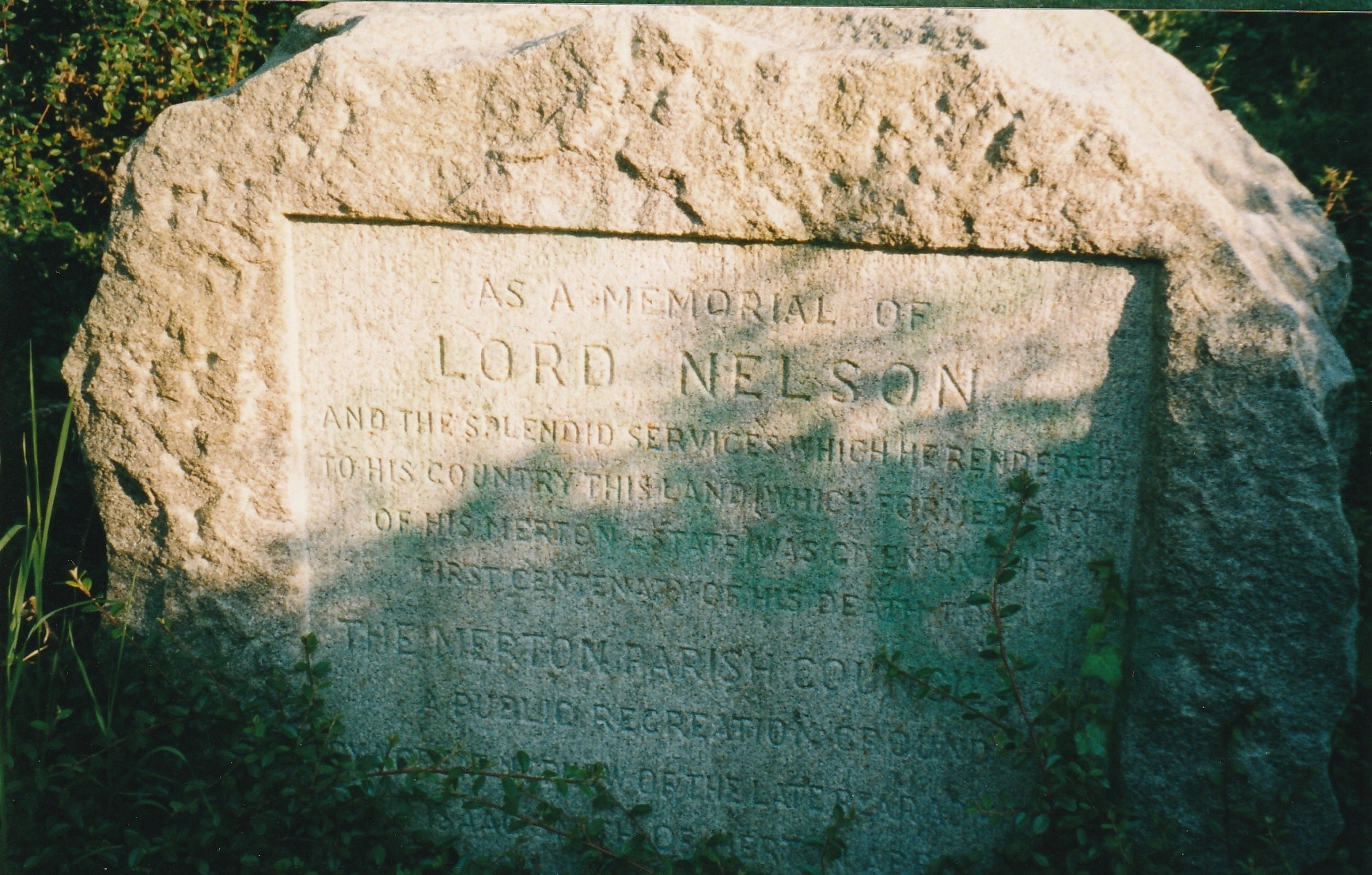Nelson Gardens (Merton)
Brief Description
Nelson Gardens opened in 1906, created to honour the first centenary of Admiral Lord Nelson's death in 1805. Nelson had lived at Merton Place from 1801-1805, which had extensive estate lands within which was the plot that is now Nelson Gardens. When the adjacent road junction was constructed, the garden was used as builders' ground but it was recreated in c.1985 and replanted using plans from 1911, with lawns, a perimeter path and flower beds, hedged to the road. The entrance has the original gates with brick and stone gate piers. Two 12 pounder guns flank a block of stone with an inscription about the garden's dedication. The land for the adjacent St John the Divine Church was also donated to mark the anniversary of Nelson's death at the Battle of Trafalgar, and was built in 1914.
During WW2 air-raid shelters in Nelson Gardens were built to protect members of the public who were on the streets at the time of an enemy attack. On 16th August, 1940, Mitcham experienced the first sustained attack of the Blitz. One bomb fell in Nelson Gardens itself.
Practical Information
- Previous / Other name:
- Nelson Gardens Open Space
- Site location:
- High Path/ off Morden Road
- Postcode:
- SW19 2JX
- What 3 Words:
- grapes.shades.entire
- Type of site:
- Public Gardens
- Borough:
- Merton
- Open to public?
- Yes
- Opening times:
- 8am - dusk (weekdays); 9am - dusk (weekends/bank holidays)
- Special conditions:
- Facilities:
- Events:
- Public transport:
- Tube: South Wimbledon (Northern). Bus: 57, 93, 152, 493
- Research updated:
- 21/06/2025
- Last minor changes:
- 31/07/2025
Please check with the site owner or manager for latest news. https://www.merton.gov.uk/leisure-recreation-and-culture/parks-and-open-spaces/parks-and-recreation-grounds/wimbledon/nelson-gardens
Full Site Description
The site for Nelson Gardens and St John the Divine Church was gifted by J. Mackerell, the great nephew of Rear Admiral Isaac Smith (1752-1831), the first European to set foot in Australia in 1770. Smith was the cousin of Captain James Cook's wife Elizabeth and sailed with Cook a number of times between 1770 and 1775. Smith is buried in Merton parish churchyard of St Mary the Virgin. In Nelson gardens, flanked by 2 cannons that may once have adorned the lawn of Merton Place, is a block of stone within an area of shrub planting that has an inscription giving the following details of the garden's dedication: 'As a memorial of Lord Nelson and the splendid services which he rendered to his country this land (which formed part of his Merton estate) was given on the first centenary of his death to the Merton Parish Council for a public recreation ground by a great nephew of the late Rear Admiral, Isaac Smith of Merton Abbey'.
Nelson had made his home in Merton with Sir William and Lady Hamilton, and lived at Merton Place from 1801-1805 before he went to meet his death at Trafalgar. The estate lands were extensive, comprising around 65 hectares in Nelson's time, but most of it was built over from the C19th onwards, and the house itself was demolished and is now covered by Nelson Grove Road.
WW2 air-raid shelters were built in Nelson Gardens to protect members of the public who were on the streets at the time of an enemy attack. They were put up as part of a big government building programme that began as early as March 1940. Intended to accommodate up to 50 people, they ‘were formed of concrete arches or shells buried partly or completely below ground level, with an entrance which was approached by steps and screened by a concrete or brick blast wall’ (A quote from ‘Safe as Houses’ by Norman Plastow).
On 16th August, 1940, Mitcham experienced the first sustained attack of the Blitz. One bomb fell in Nelson Gardens itself, killing Mr Eaton, a St. John’s Ambulance man, outside the public shelter and damaging the windows and stonework of St. John’s church (see Merton Historical Society Bulletin No 166 June 2008). Another fell on nearby High Path, killing two ARP wardens; two more fell on nearby Milner Road, one on Morden Road a few yards south of Milner road, three more on or near Pincott Road and three to the south and East of Rodney Place.
Sources consulted:
A Saunders, ‘The Art and Architecture of London’, Oxford, 1984; Peter Hopkins 'A History of Lord Nelson's Merton Place', Merton Historical Society, 1998; Bridget Cherry & Nikolaus Pevsner, The Buildings of England: London 2: South (Penguin) 1999; LB Merton 'Nelson Trail' (n.d.)
Further Information (Planning and Conservation)
- Grid ref:
- TQ258698 (525818,169827)
- Size in hectares:
- 0.36
- Site ownership:
- LB Merton
- Site management:
- Leisure and Culture Services
- Date(s):
- 1906; 1985
- Designer(s):
- Listed structures:
- TQ258698
- On National Heritage List for England (NHLE), Parks & Gardens:
No- Registered common or village green on Commons Registration Act 1965:
No- Protected under London Squares Preservation Act 1931:
No
Local Authority Data
The information below is taken from the relevant Local Authority's planning legislation, which was correct at the time of research but may have been amended in the interim. Please check with the Local Authority for latest planning information.
- On Local List:
- No
- In Conservation Area:
- No
- Tree Preservation Order:
- No
- Nature Conservation Area:
- No
- Green Belt:
- No
- Metropolitan Open Land:
- No
- Special Policy Area:
- No
- Other LA designation:
- None
Photos
Nelson Gardens: Dedication Stone, June 2002. Photograph Sally Williams
Click a photo to enlarge.
Please note the Inventory and its content are provided for your general information only and are subject to change. It is your responsibility to check the accuracy.










